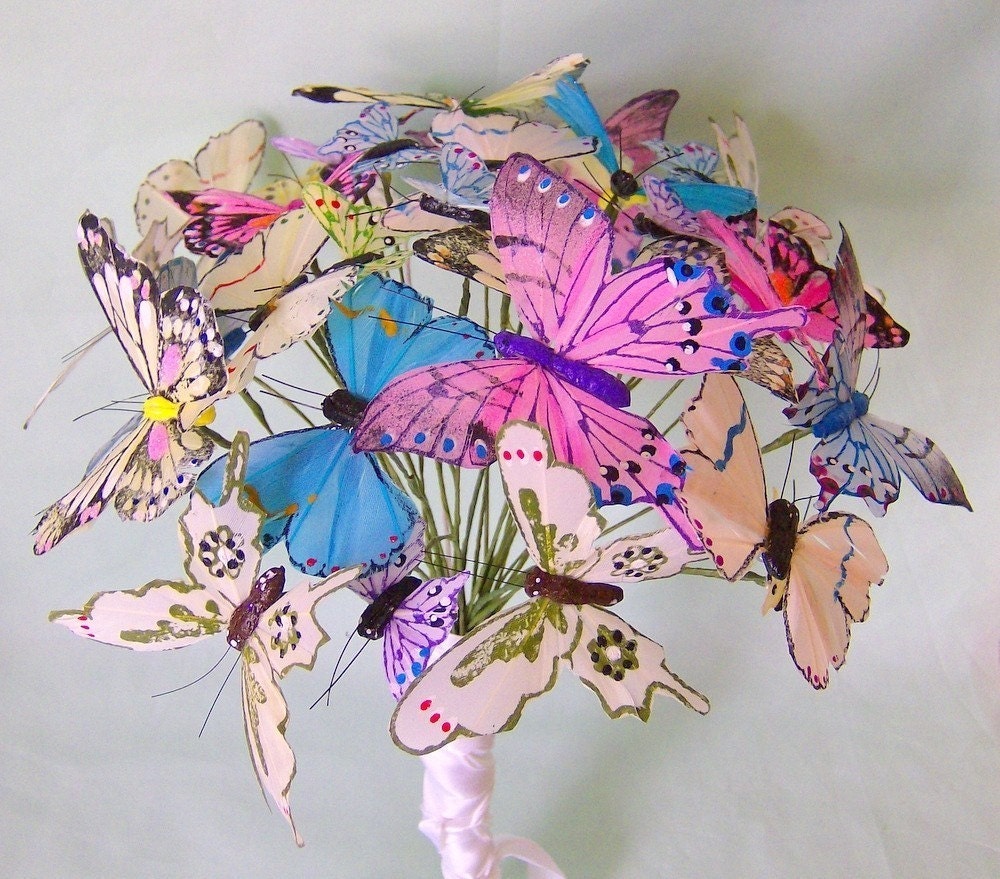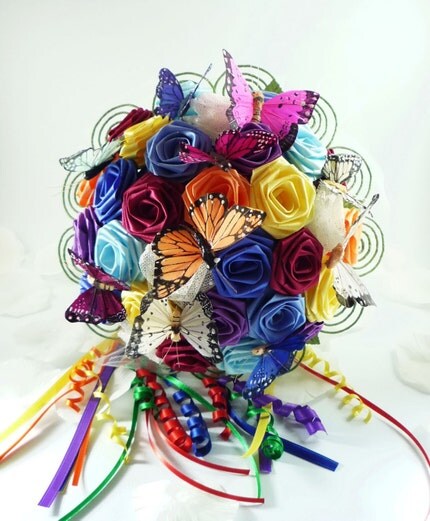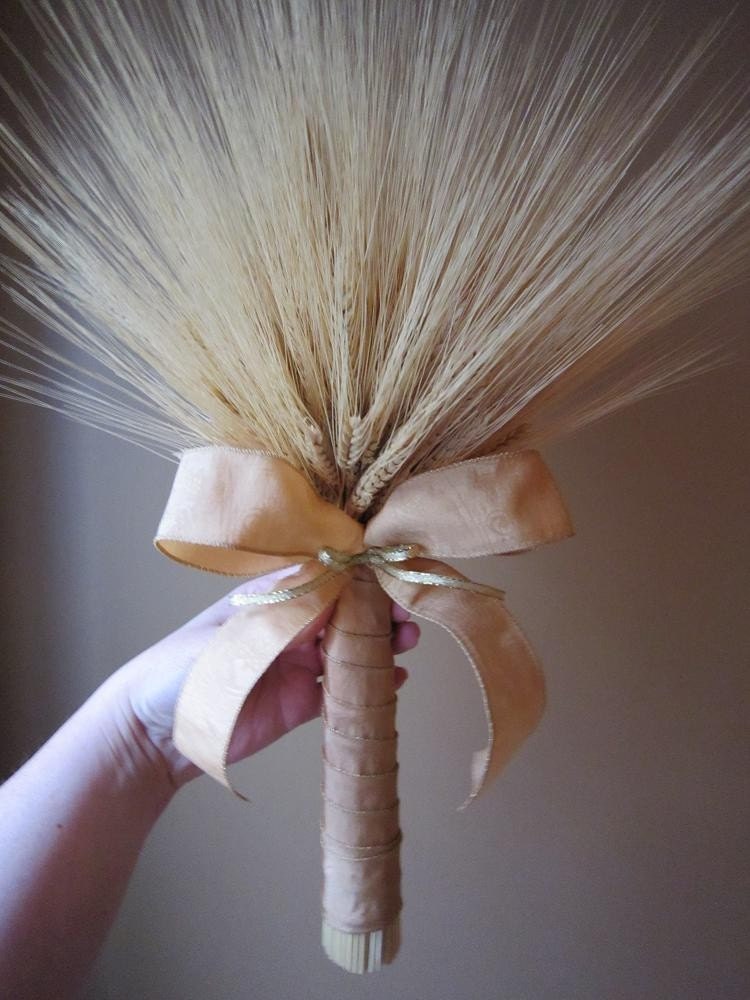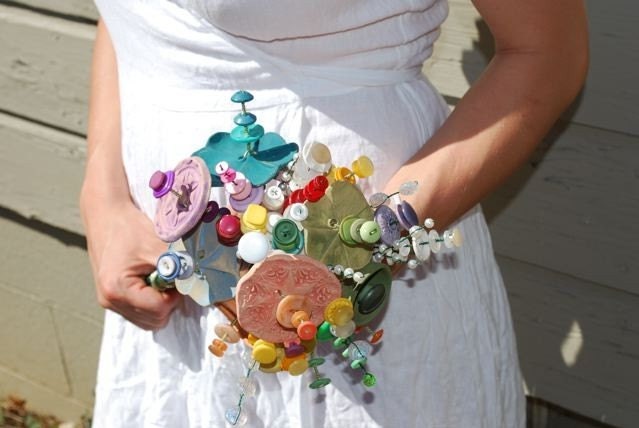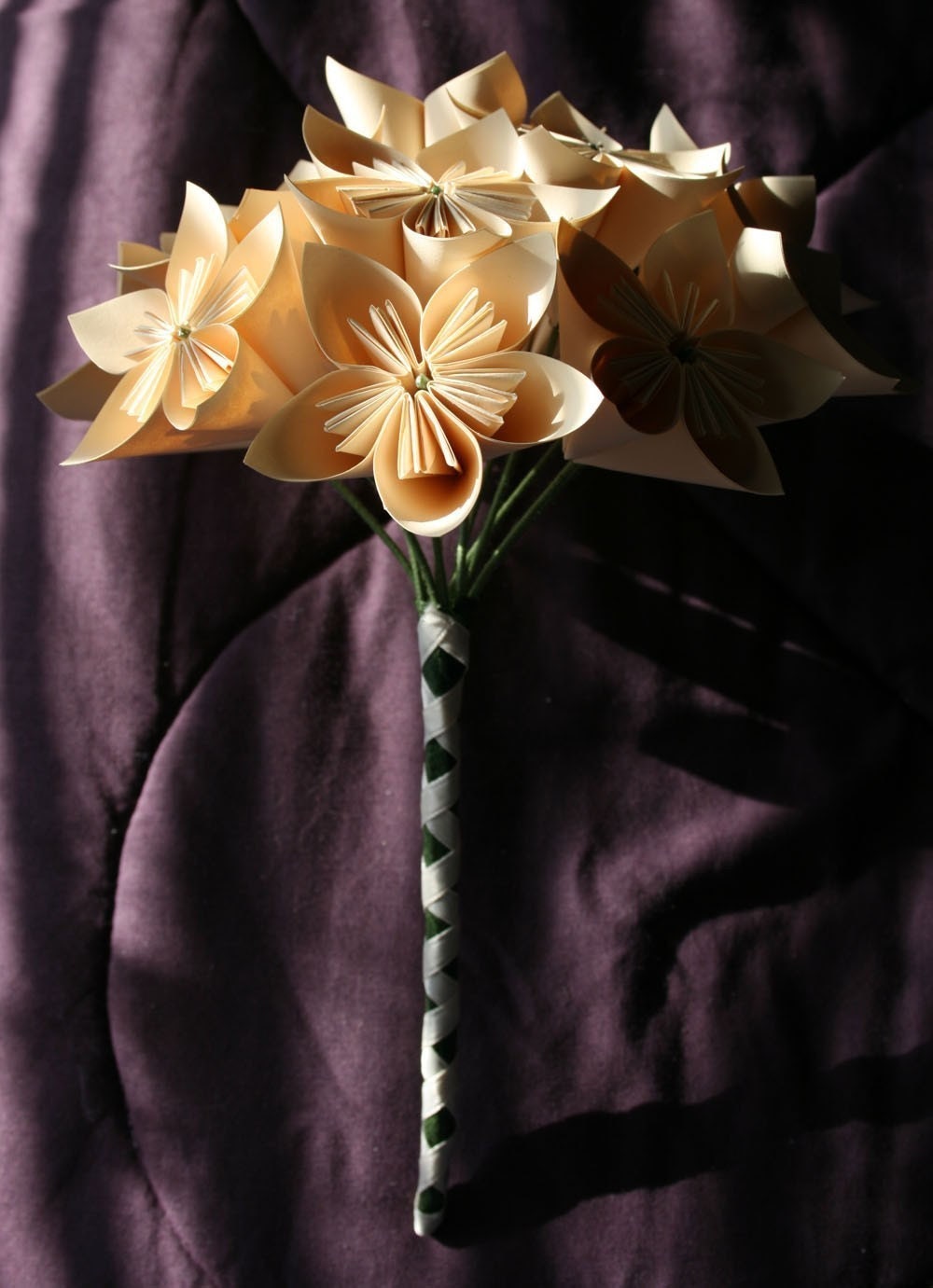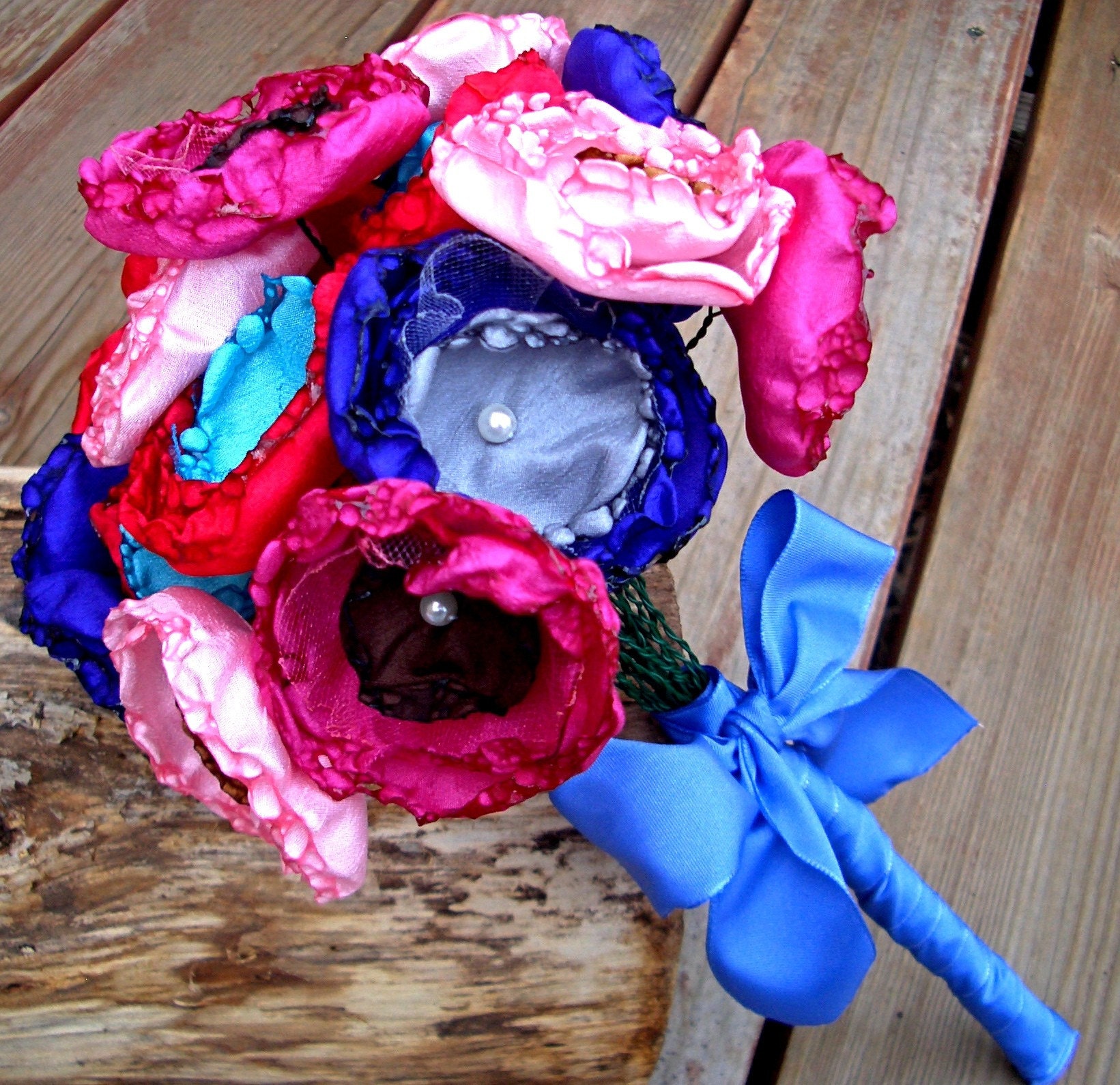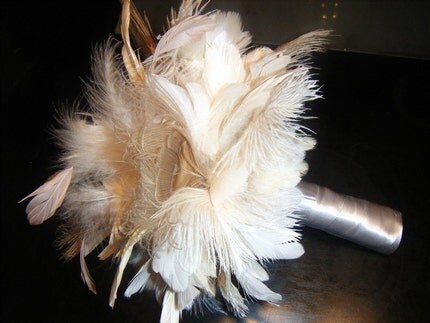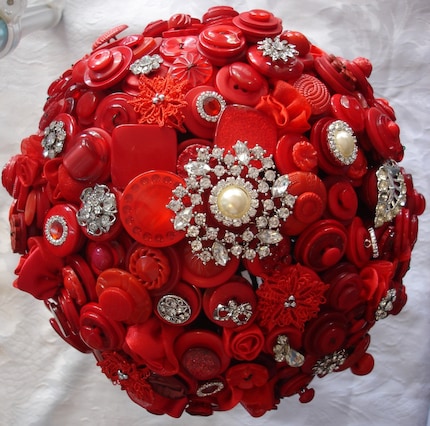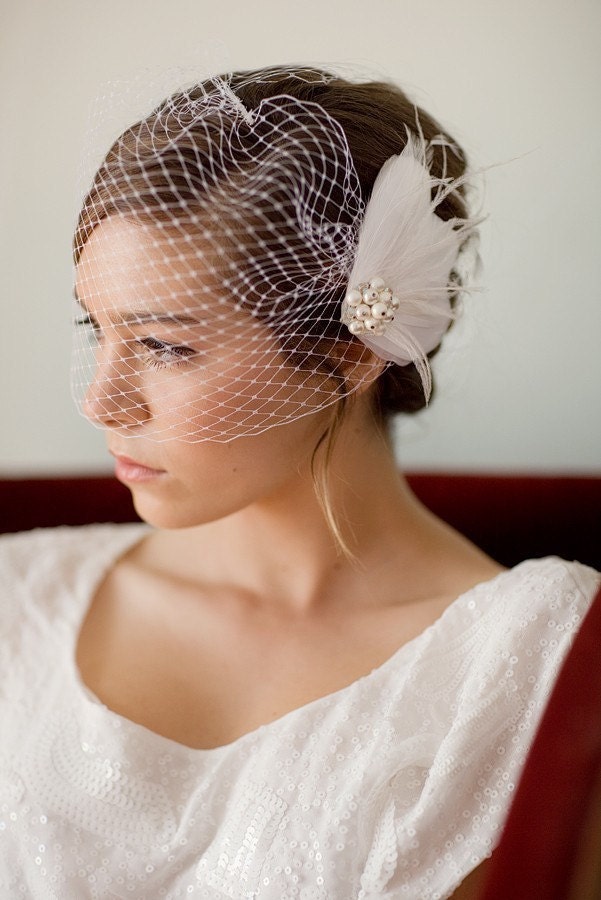Sunday, May 23, 2010
The Wedding Bouquet
So, in the area of wedding bouquets the options are endless; the most common of course is the traditional flower bouquet that the bride will hold as she walks down the aisle to the arms of her lover. Then, there are those that are not so common- and this is where adventurous and creative brides rule.
Below are some pretty interesting wedding bouquets- redefined by those brides that like to walk the road less traveled.
Check 'em out:
this would be for the bride that will marry her Poseidon.
for the bride that loves butterflies.
for the bride that likes her origami.
This is a bouquet made out of wheat branches, interesting!
The button bouquet
more origami.
Silk flower bouquet with a bunch of cool colors.
the peacock feather bouquet if you like flamboyancy
This is a really nice soft feather bouquet
and this lovely red one.
You can find these and more on Etsy.com.
As for my bouquet--- i'm still trying to determine what that will be.
Below are some pretty interesting wedding bouquets- redefined by those brides that like to walk the road less traveled.
Check 'em out:
this would be for the bride that will marry her Poseidon.
for the bride that loves butterflies.
for the bride that likes her origami.
This is a bouquet made out of wheat branches, interesting!
The button bouquet
more origami.
Silk flower bouquet with a bunch of cool colors.
the peacock feather bouquet if you like flamboyancy
This is a really nice soft feather bouquet
and this lovely red one.
You can find these and more on Etsy.com.
As for my bouquet--- i'm still trying to determine what that will be.
Wednesday, May 19, 2010
More wedding to-do's- the decor
I yearned for this day to come, the day when i would finally be able to honker down and start doing "the fun stuff"- wedding decorations. I waited patiently for months, trying to focus on the big ticket items so as not to get distracted and lose sight of the things that needed to get taken care of in advance: venue, dress, shoes, music, food, officiant, etc. But those days are now behind me (us) and I can begin to think about color scheme, decorations, those things that pull it all together and bring your theme to life.
I began doing a bit of research a few months and discovered this site: colourlovers.com a community of people united by one central interest: color. Here you can create your own color palettes and patterns. YOu can even name your "color" if it hasn't yet been "discovered" by the community.
Here are a few of my palettes inspired by the wedding venue and Frida that I think will help bring the theme (Modern Vintage with a Mexican Twist) to life:

Color by COLOURlovers
and
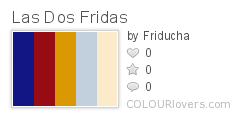
Color by COLOURlovers
Las Dos Fridas was literally inspired by the painting. I don't think that i can use those colors, but I like it anyway.
Here's the pic it's based on:
So, there you have it, and i think i need to keep creating more palettes. It's quite fun! Hopefully i'll be able to nail down the final one very soon!
I began doing a bit of research a few months and discovered this site: colourlovers.com a community of people united by one central interest: color. Here you can create your own color palettes and patterns. YOu can even name your "color" if it hasn't yet been "discovered" by the community.
Here are a few of my palettes inspired by the wedding venue and Frida that I think will help bring the theme (Modern Vintage with a Mexican Twist) to life:

Color by COLOURlovers
and

Color by COLOURlovers
Las Dos Fridas was literally inspired by the painting. I don't think that i can use those colors, but I like it anyway.
Here's the pic it's based on:
So, there you have it, and i think i need to keep creating more palettes. It's quite fun! Hopefully i'll be able to nail down the final one very soon!
Monday, May 3, 2010
a veil i always knew i wanted, but now that i have it, i don't know how to wear it!
When I realized I was getting married, I already knew what my "look" would be. I've always had a soft spot for the vintage celebration of femininity and knew that I wanted lace, lots of it. I also knew what sort of veil I wanted- the birdcage type; it speaks of a different era and its femininity is less puritan and more so that of a woman with confidence and flirtatious style. Maybe i'm just making shit up.
Last week I received my birdcage veil, and that's when I found that I have no clue how to wear it! It's quite funny actually because I have seen hundreds of pictures of models wearing these and never did it occur to me that well, it probably looked easier on "paper"! And that's how my research began.
Veil source: LoBoheme, Etsy.com
So class, here's a bit of history on the wedding veil courtesy of Wikipedia, some of the history is quite interesting.
Last week I received my birdcage veil, and that's when I found that I have no clue how to wear it! It's quite funny actually because I have seen hundreds of pictures of models wearing these and never did it occur to me that well, it probably looked easier on "paper"! And that's how my research began.
Veil source: LoBoheme, Etsy.com
So class, here's a bit of history on the wedding veil courtesy of Wikipedia, some of the history is quite interesting.
History
The first recorded instance of veiling for women is recorded in an Assyrian legal text from the 13th century BCE, which restricted its use to noble women and forbade prostitutes and common women from adopting it. Ancient Greek texts have also spoken of veiling and seclusion of women being practiced among the Persian elite. Statues from Persepolis depict women both veiled and unveiled, and it seems to be regarded as an attribute of prostitution.
Classical Greek and Hellenistic statues sometimes depict Greek women with both their head and face covered by a veil. Caroline Galt and Lloyd Llewellyn-Jones have both argued from such representations and literary references that it was commonplace for women (at least those of higher status) in ancient Greece to cover their hair and face in public.
For many centuries, until around 1175, Anglo-Saxon and then Anglo-Norman women, with the exception of young unmarried girls, wore veils that entirely covered their hair, and often their necks up to their chins (see wimple). Only in the Tudor period(1485), when hoods became increasingly popular, did veils of this type become less common.
[...]
Wedding veils
An occasion on which a Western woman is likely to wear a veil is on her wedding day, if she follows the traditions of a white wedding. Brides used to wear their hair flowing down their back at their wedding to symbolise their virginity, now the white diaphanous veil is often said to represent this.
It is not altogether clear that the wedding veil is a non-religious use of this item, since weddings have almost always had religious underpinnings, especially in the West: in the Christian tradition this is expressed in the Gospel passage, "What therefore God has joined together, let no man put asunder" (Mt. 19:6). Veils, however, had been used in the West for weddings long before this. Roman brides, for instance, wore an intensely flame-colored and fulsome veil, called the flammeum, apparently intended to protect the bride from evil spirits on her wedding day.
The lifting of the veil was often a part of ancient wedding ritual, symbolising the groom taking possession of the wife, either as lover or as property, or the revelation of the bride by her parents to the groom for his approval.
In Judaism, the tradition of wearing a veil dates back to biblical times. When Rebekah went to meet her betrothed, Isaac, she veiled herself as he approached. The veiling was both a symbol of modesty, and a definition of her personal space. Rebekah is known as the most self-assured of the matriarchs, and by veiling herself she indicated that she would still be her own person even when she would be living her life with Isaac. [8]. It is important to note that Rebekah did not veil herself when traveling with men to meet Isaac, but only did so when he was approaching. Just before the wedding ceremony the badeken or bedeken is held. The groom places the veil over the bride's face, and either he or the officiating Rabbi gives her a blessing. The veil stays on her face until just before the end of the wedding ceremony - when they are legally married according to Jewish law - then the groom helps lift the veil from off her face.
The most often cited interpretation for the badeken is that when Jacob went to marry Rachel, his father in law Laban tricked him into marrying Leah, Rachel's older and homlier sister. Many say that the veiling ceremony takes place to make sure that the groom is marrying the right bride! Some say that as the groom places the veil over his bride, he makes an implicit promise to clothe and protect her. Finally, by covering her face, the groom recognizes that he his marrying the bride for her inner beauty; while looks will fade with time, his love will be everlasting. in some ultra-orthodox traditions the bride wears an opaque veil as she is escorted down the aisle to meet her groom. This shows her complete willingness to enter into the marriage and her absolute trust that she is marrying the right man. In Judaism, a wedding is not considered valid unless the bride willingly consents to it.
In ancient Judaism the lifting of the veil took place just prior to the consummation of the marriage in sexual union. The uncovering or unveiling that takes place in the marriage ceremony is a symbol of what will take place in the marriage bed. Just as the two become one through their words spoken in wedding vows, so these words are a sign of the physical oneness that they will consummate later on. The lifting of the veil is a symbol and an anticipation of this.
In the Western world, St. Paul's words concerning how marriage symbolizes the union of Christ and His Church may underlie part of the tradition of veiling in the marriage ceremony [9].
Subscribe to:
Posts (Atom)






